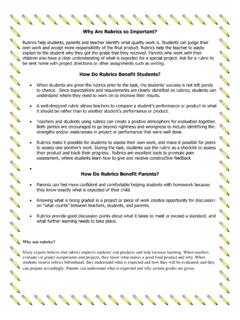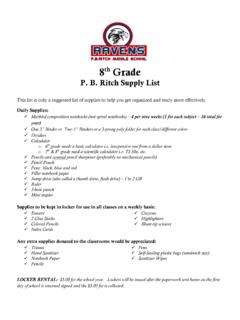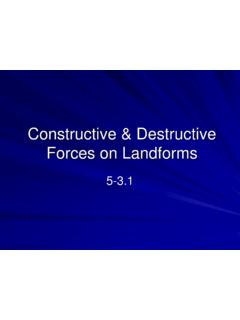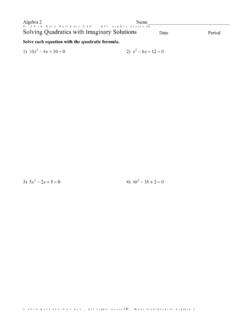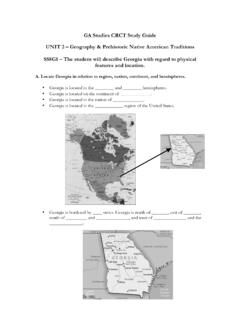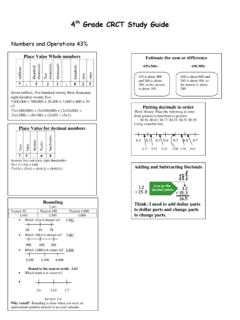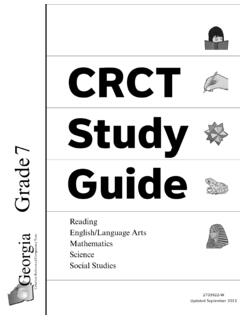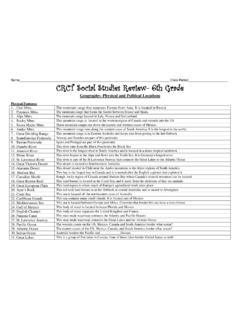Transcription of Physical Science CRCT Study Guide Notes - …
1 Physical Science Study Guide Notes Standard S8P1 Students will examine the scientific view of the nature of matter a. Distinguish between atoms and molecules. Matter is made up of tiny moving particles called atoms and molecules. Two or more atoms can join together to form a molecule. Molecules are the building blocks of matter. Atoms are tiny particles composed of protons, electrons, and neutrons. b. Describe the difference between pure substances (elements and compounds) and mixtures. An element is a substance that is made up entirely of the same type of atom. A compound is a molecule that contains at least two different elements that are chemically bonded.
2 A mixture is made up of two or more substances that can be separated back to their original components (because they are combined physically but not chemically c. Describe the movement of particles in solids, liquids, gases, and plasmas states In gases, particles move faster than those in liquids or solids. In liquids, particles move faster than in solids. There is little movement or space between the particles in a solid substance d. Distinguish between Physical and chemical properties of matter as Physical ( , density, melting point, boiling point) or chemical ( , reactivity, combustibility).)
3 What do properties mean? The properties of a substance are those characteristics that are used to identify or describe it. Physical properties are readily observable and will retain the same composition (nothing new is created). Color, size, odor, luster, hardness, melting point, boiling points, conductivity, density (mass divided by volume) Changes in state of matter ( melting, boiling, freezing, and condensing) do not create a new substance and retain their original composition and is therefore a Physical property Chemical properties are only observable during a chemical reaction and allows for change (something new is created).
4 The property is the ability to change whereas the change is the action itself. Reactivity (describes how easily something reacts with something else), combustibility (a substance or material that is able or likely to catch fire and burn) Distinguish between changes in matter as Physical ( , Physical change) or chemical (development of a gas, formation of precipitate, and change in color). Physical change- any change in size, shape, or form, or state where the identity of the matter stays the same Ex. Melting, freezing, condensing, evaporating, breaking, cutting, bending Chemical change- occurs when one type of matter changes into a different type of matter with different properties.
5 Substances before a chemical change are reactants. After a chemical change, the new substances are formed; they are called products. After a chemical change, the product cannot go back to its original reactants Many reactions involve heat. Some produce a gas- bubbling. Formation of precipitate (to cause a solid to separate out from a solution) and changes in color are also observable evidence. Ex. Burning, digestion, respiration, photosynthesis, decomposition, and rusting. f. Recognize that there are more than 100 elements and some have similar Properties as shown on the Periodic Table of Elements. They are arranged by increasing atomic number (left to right, up to down).
6 The square has the atomic number, atomic mass, element name, and element s chemical symbol. Properties of an element can be predicted from its location in the periodic table. Each horizontal row of the table is called a period (7 periods) where each row represents the number of energy levels present in an atom of the element. The columns are called groups (18 groups). Elements in each group have similar characteristics. Metals are located on the left, Nonmetals on the right, metalloids are in a zigzag line between metals and nonmetals Elements located on the left of the Periodic Table are most reactive metals, least reactive in the middle, nonmetals on the right Atomic# = #of protons or electrons /Atomic mass(weight)= #of protons + neutrons/ # of Neutrons= Atomic # - Atomic mass(weight) Standard-S8P2 -Students will be familiar with the forms and transformations of energy a.
7 Explain energy transformation in terms of the Law of Conservation of Energy. According to the Law of Conservation of Energy, energy cannot be created or destroyed. Energy always comes from somewhere and goes somewhere. Energy can be changed from one form to another. Ex. Battery (stored chemical energy) converts to light energy in a flashlight. We partake daily in energy transformations b. Explain the relationship between potential and kinetic energy. Kinetic energy is the energy of motion and is based on mass and velocity of an object. (Ex. A car speeding, Throwing a rock, or A flowing river.)
8 Potential energy is stored energy that results from an object s position or shape and is based on height and weight of an object. (Ex. A stretched rubber band, A parked car, or an uneaten plate of food.) *An increase in Kinetic energy results in a decrease of Potential energy. An increase in Potential energy results in a decrease of Kinetic Energy. c. Compare and contrast the different forms of energy (heat, light, electricity, mechanical motion, and sound) and their characteristics. Energy appears in different forms. Heat energy is in the wild or random motion of molecules (form of thermal) between two objects with different temperatures.
9 (Ex. Steaming water or space heater) Mechanical energy is in moving bodies and transfer of energy. (Mechanical energy = potential energy + kinetic energy) Light (radiant) energy is electromagnetic energy that travels in transverse waves and that doesn t need a medium. (Ex. Microwave) Electrical energy is the movement of electrical charges. (Ex. Electricity or generator) Sound is the movement of energy through substances by vibrating matter in longitudinal waves.( ex. Guitar or a microphone) d. Describe how heat can be transferred through matter by the collisions of atoms (conduction) or through space (radiation).
10 In a liquid or gas, currents will facilitate the transfer of heat (convection). When heat is transferred, thermal energy (heat) always moves from warmer to cooler objects. The warmer object loses thermal energy (heat) and becomes cooler as the cooler object gains thermal energy (heat) and becomes warmer until both reach the same temperature. Heat can be transferred by conduction, convection, and radiation Conduction is the transfer of heat by direct contact. Conduction occurs most easily in solids. (Ex. Ice cube melting in your hand.) Radiation is heat transfer that occurs when heat is transferred by electromagnetic waves.
